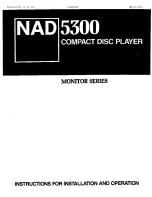
For full warranty information, refer to the AMX Instruction Manual(s) associated with your Product(s).
065-004-2781 8/06
©2006 AMX. All rights reserved. AMX and the AMX logo are registered trademarks of AMX.
AMX reserves the right to alter specifications without notice at any time.
3000 RESEARCH DRIVE, RICHARDSON, TX 75082 • 800.222.0193 • fax 469.624.7153 • technical support 800.932.6993 • www.amx.com
93-2179
REV: J
1.
First verify that the PowerFile is powered up (the power switch is located on the
lower-left of the front panel), and communicating with the PC and the target
MAX Server (refer to “Step 2: Verifying Communication Between the PC, Pow-
erFile and MAX Server” for details).
2.
Select
Changer > Load Range
or
Load All
from the MAX MDL200 menu bar.
The
Changer > Load Range
and
Load All
options operate the same, except
that Load Range allows you to specify a range of slots to load (in the
Start Disc/
End Disc
fields).
3.
This prompts the PowerFile to present each open slot on the disc carousel so
that you can load a disc into each one. If there are already some discs loaded
in the carousel, the PowerFile will automatically skip any slot positions that are
already occupied and present the next open slot for loading.
You will hear the PowerFile’s internal carousel spin to the next available empty
slot and stop. At this point you have approximately 10 seconds to insert a disc.
Note that at this point the discs that have been loaded are indicated on the MAX
MDL200 main screen, but without any title or media information since they have not
yet been identified by the program.
Step 4: Loading Media to the Target MAX Server
Once all of the disks have been loaded into the PowerFile, you are ready to load
DVD and CD media to the MAX server.
Step One: Verify the Transfer Setting
Before you start, select
File > Settings
to open the Settings dialog and set the
Record discs with multiple matches
option to the desired setting:
•
If set to Yes
: Discs that were not positively identified will be transferred. As a
result, these discs will not have any disc information associated with them.
•
If set to No
: This option causes the PowerFile to skip transferring any discs
that have multiple title matches, or that are not positively identified. These discs
can later be identified manually, by transferring the same range of discs again.
Since MAX MDL200 will not attempt to transfer any disc that has already been
marked as transferred, it will only transfer the discs that were manually identi-
fied.
This is the default (and recommended) setting.
Step Two: Transfer Discs
Once the discs have been loaded into the PowerFile, you can begin the process of
transferring the media:
1.
Set the First Disc/Last Disc range on each drive.
Note
: The first disc on Drive 2 must be greater than the last disc of Drive 1
(valid disc numbers are
1-200
).
2.
Press the
Record
button to begin transferring (on the drive(s) that you want to
use), and let the PowerFile run until the process is complete.
3.
The status of each disc is indicated in the
Status
column as it is being identified
and transferred. Once complete, the Status message indicates that the media
was successfully loaded on the MAX server. Note that the PowerFile loads one
disc at a time per drive.
4.
As each disc is read it is automatically loaded to the MAX server.
5.
MAX MDL200 displays a message to inform you when all discs in the specified
range have been loaded to the server.
6.
Once the process is complete, you should verify the contents of the MAX
server via the WinMAX application (
Movies
and
Music
tabs).
Note
: You can use the WinMAX application to re-identify any discs that display
with incorrect or incomplete disc information If necessary. You can also use
WinMAX to manually enter/edit disc information as needed. Refer to the Win-
MAX Instruction Manual (available online at www.amx.com) for details.
If one or more discs cannot be identified:
While MAX MDL200 settings can allow you to proceed with transferring discs that
could not be identified, it is recommended that you set MAX MDL200 to skip discs
with multiple matches. Once the transfer process is complete, these discs can be
identified manually by selecting the best title match for each from the multiple
possible title matches found in the database.
1.
Double-click on a title in MAX MDL200 to open the Multiple Matches dialog.
2.
Specify a search method (
Title
- default setting or
UPC
). Enter the disc title (or
UPC code) in the Search field. The results are displayed in the lower window.
•
If you selected to search by
Title
, enter part of the title of the desired CD or
DVD. For best results, enter a single word and let the program return a list of all
titles that contain that word. Use a multi-word search to refine the results if nec-
essary.
•
If you selected to search by
UPC
, enter the UPC code as it appears on the disc
packaging.
•
For either search method, avoid using asterisks or other wild-card characters
to achieve the best results.
3.
Click the
Search
button.
4.
Select the best match and click
OK
to assign the selected title (and associated
media information) to the disc.
Verifying Disc Information
In some cases in which the program has indicated more than one possible match for
a disc, it may not be obvious which of the possible matches represents the best
match for the disc. In these cases you should eject the disc momentarily so that you
can visually check the physical label on the disc. The Eject and Load buttons on the
Multiple Matches dialog allow you do this quickly:
1.
Double-click on the disc/slot in question (in the Disc/Slot Window) to access
the Multiple Matches dialog. Review the list of possible title matches in this
dialog.
2.
Click on the
Eject
button in the Multiple Matches dialog. This option ejects the
disc from the PowerFile. Remember that you have approximately 10 seconds
to remove the disc from the slot.
Note that by using the Eject and Load buttons in the Multiple Matches dialog,
the program retains any disc information that exists for this disc.
This is also true for the Load and Eject buttons in the New Title Entry dialog.
By contrast, if you eject a disc from the PowerFile via the Eject options in the
Changer menu, or the Disc Context Menu, all disc information is lost. These
options are intended to be used at the point that the disc is being permanently
removed from the PowerFile, once the loading process is complete.
3.
Look at the disc label to discern which of the possible title matches best
matches this disc.
4.
Press the
Load
button in the Multiple Matches dialog, and replace the disc in
the Disc Loading Slot.
5.
Select the best possible match in the Multiple Matches dialog and click
OK
.
Note
: Do not close the Multiple Matches (or New Title Entry dialog) until the
disc has been reloaded. If the dialog is closed while the disc is still ejected, the
slot will be set to <empty>, and all disc information will be lost.
Manually Entering Disc Information
If no suitable title matches are found, then you may enter the information manually
via the New Title Entry dialog:
1.
Click
New Entry
in the Multiple Matches dialog to open the New Title Entry dia-
log. This dialog contains a text field where you can manually enter a title for this
disc. For DVDs, you can also associate a
Genre
,
Aspect Ratio
and
Sound
option to the disc.
If necessary. you can use the
Eject
and
Load
buttons in the New Title Entry
dialog to eject the disc so that you can review any information that is printed on
the disc label:
a. Press
Eject
to eject the disc (at which point you have approximately 10
seconds to physically remove the disc from the disc loading slot on the
PowerFile).
b. When you’re finished, press the
Load
button and replace the disc (label-
side facing to the right) in the carousel (you have 10 seconds after
pressing the Load button to insert the disc).
2.
Click inside the
Title
text field, and type the title that you want to associate with
this disc.
3.
For DVDs, use the drop-down menus to select a
Genre
,
Aspect Ratio
and
Sound
option, and click
OK
to accept the new disc information.
Removing Discs From The PowerFile
When you’re finished transferring all of the discs in the PowerFile, remove them from
the unit:
•
To unload a single disc, right-click on the disc title and select
Eject
from the
context menu.
•
To unload a selected range of discs, select
Changer > Eject Range
and spec-
ify the range of discs you want to eject (in the
Start Disc/End Disc
fields).
•
Alternatively you can use the
Changer > Eject All
command to eject all of the
discs.
In any case, as each disc is ejected, it must be manually removed from the carousel
on the front of the PowerFile. You have 10 seconds to remove the disc before it is
pulled back into the unit and the eject command is cancelled.
Clearing Disc Information From the Disc/Slot Window
By default, all disc information is displayed in the Disc/Slot Window until it is
manually cleared. Select
File > Reset All
to reset (clear) all of the disc information in
the Disc/Slot Window.
The
Reset All
command also stops the transfer and/or identification processes.
Troubleshooting Ethernet Communications Problems
•
The Link (L) LED next to the Ethernet port on the MAX server should be on. If
not, check your cables and connectors.
•
Verify that the IP address and Subnet Mask settings are appropriate for your
network configuration.
•
If you are connecting to the server via a direct connection with a PC (using a
crossover Ethernet cable), be sure that the IP Address of the Network card in
your PC is in the same range as the server, but not the same address as the
server.
For example, a network card setting of
192.168.1.31
will work with the default
server IP address of
192.168.1.30
.
DVD Region Code Settings on the PowerFile
The PowerFile has two internal DVD-ROMs, each of which may require that you
specify a DVD region code setting different than the default setting of Region 1. Note
that you can set the region code on each drive, and you may choose to specify
different region codes for each one. Refer to the
MAX-MDL200 Multi-Disc Loader
System Operation/Reference Guide
for instructions on changing the DVD Region
Code Settings.
Notice
: MAX Products are not designed or intended to, and may not be used to,
violate anyone’s copyright or other intellectual property rights. Each user of the MAX
Products may only use the Products in connection with materials legally owned or
licensed by such user and only to the extent such ownership or license rights permit
such use.




















